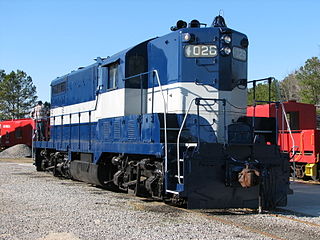Related Research Articles

Auburn is a city in Lee County, Alabama, United States. It is the largest city in eastern Alabama. The population was 76,143 at the 2020 census. It is a principal city of the Auburn-Opelika Metropolitan Area. The Auburn-Opelika, AL MSA with a population of 193,773, along with the Columbus, GA-AL MSA and Tuskegee, Alabama, comprises the greater Columbus-Auburn-Opelika, GA-AL CSA, a region home to 503,124 residents.

Opelika is a city in and the county seat of Lee County in the east-central part of the U.S. state of Alabama. It is a principal city of the Auburn-Opelika Metropolitan Area. As of the 2020 census, the population of Opelika is 30,995, an increase of 17.1 percent from the 2010 Census where the population was 26,477. The Auburn-Opelika, AL MSA with a population of 150,933, along with the Columbus, Georgia metropolitan area, comprises the Greater Columbus combined statistical area, a region home to 501,649 residents.

U.S. Route 280 is a spur of U.S. Highway 80. It currently runs for 392 miles (631 km) from Blitchton, Georgia, at US 80 to Birmingham, Alabama at I-20/I-59. For much of its route, US 280 travels through rural areas and smaller cities in southern Georgia and east central Alabama. Once the highway approaches Birmingham, it is a major suburban route. Numerous shopping centers are located on US 280 throughout northern Shelby County and southern Jefferson County.

The Southern Railway was a class 1 railroad based in the Southern United States between 1894 and 1982, when it merged with the Norfolk and Western Railway (N&W) to form the Norfolk Southern Railway. The railroad was the product of nearly 150 predecessor lines that were combined, reorganized and recombined beginning in the 1830s, formally becoming the Southern Railway in 1894.

The Georgia Railroad and Banking Company also seen as "GARR", was a historic railroad and banking company that operated in the U.S. state of Georgia. In 1967 it reported 833 million revenue-ton-miles of freight and 3 million passenger-miles; at the end of the year it operated 331 miles (533 km) of road and 510 miles (820 km) of track.
The Montgomery and West Point Railroad (M&WP) was an early 19th-century railroad in Alabama and Georgia. It played an important role during the American Civil War as a supply and transportation route for the Confederate Army, and, as such, was the target of a large raid by Union cavalry in the summer of 1864, called Wilson's Raid. The railroad played an important role in this business, and it became a symbol to industrialization in the United States. The railroads make it possible to supply large military forces that were needed in order to take over and conquer the Southern part of the United States. During the early 19th-century, turnpikes, canals, and railroads all brought people to the west and more products to the east. There was an effort in Americans during this time to build a railroad that would link Georgia to trade with the Tennessee and Ohio areas, and the M&WP was a starting point in helping to accomplish this goal.

The Central of Georgia Railway started as the Central Rail Road and Canal Company in 1833. As a way to better attract investment capital, the railroad changed its name to Central Rail Road and Banking Company of Georgia. This railroad was constructed to join the Macon and Western Railroad at Macon, Georgia, in the United States, and run to Savannah. This created a rail link from Chattanooga, on the Tennessee River, to seaports on the Atlantic Ocean. It took from 1837 to 1843 to build the railroad from Savannah to the eastern bank of the Ocmulgee River at Macon; a bridge into the city was not built until 1851.
The Western Railway of Alabama (WRA) also seen as "WofA" was created as the Western Railroad of Alabama by the owners of the Montgomery & West Point Railroad (M&WP) in 1860. It was built to further the M&WP's development West from Montgomery, Alabama to Selma, Alabama. When the line was constructed in 1870, the M&WP was merged into the WRA, creating a line from Selma to West Point, Georgia. It served Auburn, Alabama and connected in Opelika, Alabama to the Central of Georgia line from Columbus, Georgia to Birmingham, Alabama. Although it was partially owned by the Central of Georgia around the turn from the nineteenth to the twentieth century, it did not end up being owned by Norfolk Southern when that company came into existence due to the merger of the CofG's parent, the Southern Railway, and the Norfolk & Western Railway.

The Georgia Southwestern Railroad is a Class III short line railroad company that operates over 234 miles (377 km) of track in southwestern Georgia and southeastern Alabama. Beginning in 1989 as a division of the South Carolina Central Railroad on a pair of former CSX Transportation lines, the railroad has since undergone a number of transformations through abandonments and acquisitions, before arriving at its current form. The railroad was formerly a RailAmerica property before going independent, and in 2008 it was acquired by Genesee & Wyoming Inc.

The Waycross Air Line Railroad, chartered in 1887, was an air-line railroad in Georgia. It began operations between Waycross and Sessoms in 1890. In 1901, the railroad had extended as far as Fitzgerald, Georgia, at which time its charter was amended for an extension to Birmingham, Alabama, and it was renamed the Atlantic and Birmingham Railroad. That company purchased the Tifton and Northeastern Railroad and Tifton, Thomasville and Gulf Railway on December 3, 1903, changing its name to the Atlantic and Birmingham Railway. In 1906, the Atlantic and Birmingham Railway was in turn purchased by the Atlanta, Birmingham and Atlantic Railway, which continued expansion towards Birmingham.
The Chattanooga, Rome and Columbus Railroad (CR&C) was a railroad in Georgia.
The Savannah and Western Railroad is a historic railroad that was located in Georgia.
The Savannah and Memphis Railroad is a historic railroad that operated in Alabama.
The Savannah, Americus and Montgomery Railway (SA&M) was a historic railroad located in the U.S. states of Georgia and Alabama. SA&M was built in the 1880s running between Montgomery, Alabama and Lyons, Georgia. It would be completed to Savannah, Georgia in 1896 after being renamed the Georgia and Alabama Railway. The line would notably become part of the Seaboard Air Line Railroad network in 1900.

The Heart of Georgia Railroad is a shortline railroad created in 1999 to lease and operate 177 miles (285 km) of track owned by the Georgia Department of Transportation between Mahrt, Alabama and Vidalia, Georgia, in the United States. The railroad has since expanded to include more than 233 miles (375 km) of track, reaching as far as Midville, Georgia. Initially only the portion from Rochelle to Preston, Georgia was utilized, with the Preston-Mahrt and Rochelle-Vidalia lines out of service. The Heart of Georgia also hosts the SAM passenger excursion train and is owned by parent company Atlantic Western Transportation Company.

Auburn University Regional Airport with the Robert G. Pitts Field is a public use airport located two nautical miles (4 km) east of the central business district of Auburn, a city in Lee County, Alabama, United States. The airport is owned by Auburn University and was formerly known as Auburn–Opelika Robert G. Pitts Airport. It is included in the National Plan of Integrated Airport Systems for 2011–2015, which categorized it as a general aviation facility.
The Pine Belt Southern Railroad was a shortline railroad formerly operating on two disconnected track segments in east central Alabama. Upon its start in 1995 the railroad ran over a branch from Nuckols to Hurtsboro, Alabama. In 1996 a second branch was acquired, extending from Roanoke, Jct., near Opelika, to Lafayette, Alabama. Together the lines totaled 42.4 miles (68.2 km) and the railroad was controlled by Richard Abernathy.
The transportation system of Georgia is a cooperation of complex systems of infrastructure comprising over 1,200 miles (1,900 km) of interstates and more than 120 airports and airbases serving a regional population of 59,425 people.

Rousseau's Opelika Raid saw 2,700 Union cavalry led by Major General Lovell Rousseau raid deep into Alabama in the Atlanta Campaign during the American Civil War. The successful raid began at Decatur, Alabama, and was only opposed by minimal forces of the Confederate States Army. The Union raiders rode south-southeast across the state destroying Confederate supplies and public property. They wrecked as much as 30 mi (48.3 km) of the Montgomery and West Point Railroad near Opelika, Alabama. The Union cavalry then turned northeast and joined the army of Major General William Tecumseh Sherman near Marietta, Georgia, while sustaining few casualties.
References
- ↑ Cox, Jim (10 November 2010). Rails Across Dixie: A History of Passenger Trains in the American South. McFarland. p. 55. ISBN 978-0-7864-6175-2.